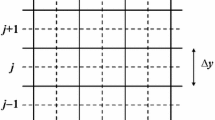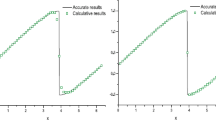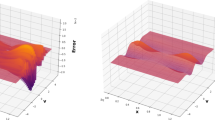Abstract
In this paper, we present a semi-Lagrangian (SL) method based on a non-polynomial function space for solving the Vlasov equation. We find that a non-polynomial function based scheme is suitable to the specifics of the target problems. To address issues that arise in phase space models of plasma problems, we develop a weighted essentially non-oscillatory (WENO) scheme using trigonometric polynomials. In particular, the non-polynomial WENO method is able to achieve improved accuracy near sharp gradients or discontinuities. Moreover, to obtain a high-order of accuracy in not only space but also time, it is proposed to apply a high-order splitting scheme in time. We aim to introduce the entire SL algorithm with high-order splitting in time and high-order WENO reconstruction in space to solve the Vlasov-Poisson system. Some numerical experiments are presented to demonstrate robustness of the proposed method in having a high-order of convergence and in capturing non-smooth solutions. A key observation is that the method can capture phase structure that require twice the resolution with a polynomial based method. In 6D, this would represent a significant savings.











Similar content being viewed by others
References
Besse, N., Latu, G., Ghizzo, A., Sonnendrücker, E., Bertrand, P.: A wavelet-MRA-based adaptive semi-Lagrangian method for the relativistic Vlasov-Maxwell system. J. Comput. Phys. 227(16), 7889–7916 (2008)
Birdsall, C.K., Langdon, A.B.: Plasma Physics Via Computer Simulation. McGraw-Hill, New York (1985)
Blanesa, S., Moanb, P.C.: Practical symplectic partitioned Runge-Kutta and Runge-Kutta-Nystrom methods. J. Comput. Appl. Math. 142, 313–330 (2002)
Bordas, S., Nguyen, P.V., Dunant, C., Guidoum, A., Nguyen-Dang, H.: An extended finite element library. Int. J. Numer. Methods Eng. 71(6), 703–732 (2007)
Boyd, J.: Chebyshev and Fourier Spectrum Methods. Springer, New York (1989)
Burgan, J., Gutierrez, J., Fijalkow, E., Navet, M., Feix, M.: Self-similar solutions for Vlasov and water-bag models. J. Plasma Phys. 19(1), 135–146 (1978)
Cai, X., Qiu, J., Qiu, J.-M.: A conservative semi-Lagrangian HWENO method for the Vlasov equation. J. Comput. Phys. 323, 95–114 (2016)
Carrillo, J.A., Vecil, F.: Nonoscillatory interpolation methods applied to Vlasov-based models. SIAM J. Sci. Comput. 29(3), 1179–1206 (2007)
Chen, G., Chacon, L.: A multi-dimensional, energy-and charge-conserving, nonlinearly implicit, electromagnetic Vlasov-Darwin particle-in-cell algorithm. Comput. Phys. Commun. 197, 73–87 (2015)
Chen, G., Chacón, L., Barnes, D.C.: An energy-and charge-conserving, implicit, electrostatic particle-in-cell algorithm. J. Comput. Phys. 230(18), 7018–7036 (2011)
Cheng, C.-Z., Knorr, G.: The integration of the Vlasov equation in configuration space. J. Comput. Phys. 22(3), 330–351 (1976)
Cheng, Y., Christlieb, A.J., Zhong, X.: Energy-conserving discontinuous Galerkin methods for the Vlasov-Ampere system. J. Comput. Phys. 256, 630–655 (2014)
Cheng, Y., Christlieb, A.J., Zhong, X.: Energy-conserving discontinuous Galerkin methods for the Vlasov-Maxwell system. J. Comput. Phys. 279, 145–173 (2014)
Christlieb, A., Guo, W., Jiang, Y., Yang, H.: A moving mesh WENO method based on exponential polynomials for one-dimensional conservation laws. J. Comput. Phys. 380, 334–354 (2019)
Christlieb, A., Hitchon, W., Lawler, J., Lister, G.: Integral and Lagrangian simulations of particle and radiation transport in plasma. J. Phys. D Appl. Phys. 42(19), 194007 (2009)
Christlieb, A., Sands, W., Yang, H.: Superconvergent non-polynomial approximations (2020). https://arxiv.org/abs/2011.02654v2. Accessed 17 Jun 2021
Christlieb, A.J., Krasny, R., Verboncoeur, J.P., Emhoff, J.W., Boyd, I.D.: Grid-free plasma simulation techniques. IEEE Trans. Plasma Sci. 34(2), 149–165 (2006)
Colombi, S., Touma, J.: Vlasov-Poisson: the waterbag method revisited. Commun. Nonlinear Sci. Numer. Simul. 13(1), 46–52 (2008)
Crouseilles, N., Faou, E., Mehrenberger, M.: High order Runge-Kutta-Nystrom splitting methods for the Vlasov-Poisson equation. inria-00633934 (2011)
Filbet, F., Sonnendrücker, E.: Comparison of Eulerian Vlasov solvers. Comput. Phys. Commun. 150(3), 247–266 (2003)
Filbet, F., Sonnendrücker, E., Bertrand, P.: Conservative numerical schemes for the Vlasov equation. J. Comput. Phys. 172(1), 166–187 (2001)
Gibbon, P., Speck, R., Karmakar, A., Arnold, L., Frings, W., Berberich, B., Reiter, D., Mašek, M.: Progress in mesh-free plasma simulation with parallel tree codes. IEEE Trans. Plasma Sci. 38(9), 2367–2376 (2010)
Güçlü, Y., Christlieb, A.J., Hitchon, W.N.: Arbitrarily high order convected scheme solution of the Vlasov-Poisson system. J. Comput. Phys. 270, 711–752 (2014)
Ha, Y., Kim, C.H., Yang, H., Yoon, J.: Sixth-order weighted essentially nonoscillatory schemes based on exponential polynomials. SIAM J. Sci. Comput. 38, 1987–2017 (2016)
Ha, Y., Kim, C.H., Yang, H., Yoon, J.: A sixth-order weighted essentially nonoscillatory schemes based on exponential polynomials for Hamilton-Jacobi equations. J. Sci. Comput. 75, 1675–1700 (2018)
Ha, Y., Kim, C.H., Yang, H., Yoon, J.: Improving accuracy of the fifth-order WENO scheme by using the exponential approximation space. SIAM J. Numer. Anal. 59, 143–172 (2021)
Hitchon, W., Koch, D., Adams, J.: An efficient scheme for convection-dominated transport. J. Comput. Phys. 83(1), 79–95 (1989)
Hockney, R.W., Eastwood, J.W.: Computer Simulation Using Particles. McGraw-Hill, New York (1981)
Jiang, G.-S., Shu, C.-W.: Efficient implementation of weighted ENO schemes. J. Comput. Phys. 126(1), 202–228 (1996)
Karlin, S., Studden, W.: Tchebycheff Systems: with Applications in Analysis and Statistics. Interscience Publishers, Geneva (1966)
Laborde, P., Pommier, J., Renard, Y., Salaün, M.: High-order extended finite element method for cracked domains. Int. J. Numer. Methods Eng. 64(3), 354–381 (2005)
Markidis, S., Lapenta, G.: The energy conserving particle-in-cell method. J. Comput. Phys. 230, 7037–7052 (2011)
Matyash, K., Schneider, R., Sydora, R., Taccogna, F.: Application of a grid-free kinetic model to the collisionless sheath. Contrib. Plasma Phys. 48(1/2/3), 116–120 (2008)
Moës, N., Dolbow, J., Belytschko, T.: A finite element method for crack growth without remeshing. Int. J. Numer. Methods Eng. 46(1), 131–150 (1999)
Nakamura, T., Yabe, T.: Cubic interpolated propagation scheme for solving the hyper-dimensional Vlasov-Poisson equation in phase space. Comput. Phys. Commun. 120(2/3), 122–154 (1999)
Pohn, E., Shoucri, M., Kamelander, G.: Eulerian Vlasov codes. Comput. Phys. Commun. 166, 81–93 (2005)
Qiu, J.-M., Christlieb, A.: A conservative high order semi-Lagrangian WENO method for the Vlasov equation. J. Comput. Phys. 229(4), 1130–1149 (2010)
Qiu, J.-M., Russo, G.: A high order multi-dimensional characteristic tracing strategy for the Vlasov-Poisson system. J. Sci. Comput. 71(1), 414–434 (2017)
Qiu, J.-M., Shu, C.-W.: Conservative semi-Lagrangian finite difference WENO formulations with applications to the Vlasov equation. Commun. Comput. Phys. 10, 979–1000 (2011)
Qiu, J.-M., Shu, C.-W.: Positivity preserving semi-Lagrangian discontinuous Galerkin formulation: theoretical analysis and application to the Vlasov-Poisson system. J. Comput. Phys. 230(23), 8386–8409 (2011)
Rossmanith, J.A., Seal, D.C.: A positivity-preserving high-order semi-Lagrangian discontinuous Galerkin scheme for the Vlasov-Poisson equations. J. Comput. Phys. 230(16), 6203–6232 (2011)
Siddi, L., Lapenta, G., Gibbon, P.: Mesh-free Hamiltonian implementation of two dimensional Darwin model. Phys. Plasmas 24(8), 082103 (2017)
Sirajuddin, D., Hitchon, W.N.: A truly forward semi-Lagrangian WENO scheme for the Vlasov-Poisson system. J. Comput. Phys. 392, 619–665 (2019)
Sonnendrücker, E., Roche, J., Bertrand, P., Ghizzo, A.: The semi-Lagrangian method for the numerical resolution of the Vlasov equation. J. Comput. Phys. 149(2), 201–220 (1999)
Tabarraei, A., Sukumar, N.: Extended finite element method on polygonal and quadtree meshes. Comput. Methods Appl. Mech. Eng. 197(5), 425–438 (2008)
Verboncoeur, J.P.: Particle simulation of plasmas: review and advances. Plasma Phys. Control. Fusion 47(5A), A231 (2005)
Wang, B., Miller, G.H., Colella, P.: A particle-in-cell method with adaptive phase-space remapping for kinetic plasmas. SIAM J. Sci. Comput. 33(6), 3509–3537 (2011)
Watanabe, T.H., Sugama, H.: Vlasov and drift kinetic simulation methods based on the symplectic integrator. Transp. Theory Stat. Phys. 34, 287–309 (2005)
Wolf, E.M., Causley, M., Christlieb, A., Bettencourt, M.: A particle-in-cell method for the simulation of plasmas based on an unconditionally stable field solver. J. Comput. Phys. 326, 342–372 (2016)
Xiong, T., Qiu, J.-M., Xu, Z.F., Christlieb, A.: High order maximum principle preserving semi-Lagrangian finite difference WENO schemes for the Vlasov equation. J. Comput. Phys. 273, 618–639 (2014)
Xiong, T., Russo, G., Qiu, J.-M.: Conservative multi-dimensional semi-Lagrangian finite difference scheme: stability and applications to the kinetic and fluid simulations. J. Sci. Comput. 79(2), 1241–1270 (2019)
Yoshida, H.: Construction of higher order symplectic integrators. Phys. Lett. A 150, 262–268 (1990)
Zhu, J., Qiu, J.: Trigonometric WENO schemes for hyperbolic conservation laws and highly oscillatory problems. Commun. Comput. Phys. 8, 1242–1263 (2010)
Zhu, J., Qiu, J.: WENO schemes and their application as limiters for RKDG methods based on trigonometric approximation spaces. J. Sci. Comput. 55, 606–644 (2013)
Acknowledgements
We would like to thank AFOSR and NSF for their support of this work under grants FA9550-19-1-0281 and FA9550-17-1-0394 and NSF grant DMS 191218.
Author information
Authors and Affiliations
Corresponding author
Ethics declarations
Conflict of Interest
On behalf of all authors, the corresponding author states that there is no conflict of interest.
Appendices
Appendix A Formulation of \(\mathbf {C}\) and \(\mathbf {c}_k\)
The numerical flux \({\hat{f}}_{j-\frac{1}{2}}\) in (25) based on the function space \(\varGamma _5 = \mathrm{span} \{\cos {x},\sin { x}, x^2, x^3, x^4\}\) is constructed by using the coefficients
The local numerical flux \({\hat{f}}_{j-\frac{1}{2}}^k\) in (26) can be obtained based on algebraic function space \(\varPi _3 =\mathrm{span}\{1, x, x^2\}\) with the constants
or based on the function space \(\mathrm{span} \{1, \sin {x},\cos { x}\}\) with the coefficients
Appendix B Proof of Proposition 2
Assuming f smooth enough around the stencil, we can represent the smoothness indicators (28) using Taylor expansion as
Then for each \(k=0,1,2\), we can obtain
with a constant C, by choosing \(\epsilon = \Delta x^2\), so that it is straightforward by the definition of \(\omega _k\) in (29).
Rights and permissions
About this article
Cite this article
Christlieb, A., Link, M., Yang, H. et al. High-Order Semi-Lagrangian WENO Schemes Based on Non-polynomial Space for the Vlasov Equation. Commun. Appl. Math. Comput. 5, 116–142 (2023). https://doi.org/10.1007/s42967-021-00150-5
Received:
Revised:
Accepted:
Published:
Issue Date:
DOI: https://doi.org/10.1007/s42967-021-00150-5
Keywords
- Semi-Lagrangian methods
- WENO schemes
- High-order splitting methods
- Non-polynomial basis
- Vlasov equation
- Vlasov-Poisson system




